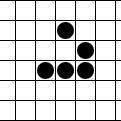

The glider is a pattern that travels across the board in Conway's Game of Life. It was first discovered by Richard K. Guy in 1969, while John Conway's group was attempting to track the evolution of the R-pentomino. Gliders are the smallest spaceships, and they travel diagonally at a speed of one cell every four generations, or . The glider is often produced from randomly generated starting configurations.[1]
The name comes from the fact that, after two steps, the glider pattern repeats its configuration with a glide reflection symmetry. After four steps and two glide reflections, it returns to its original orientation.[2] John Conway remarked that he wished he hadn't called it the glider. The game was developed before the widespread use of interactive computers, and after seeing it animated, he feels the glider looks more like an ant walking across the plane.[3]
- ^ Flammenkamp, Achim (December 9, 1995). "Spontaneous appeared Spaceships out of Random Dust". Bielefeld University. Archived from the original on April 13, 2009. Retrieved February 27, 2009.
- ^ Wainwright, Robert T. (1974). "Life is universal!". Proceedings of the 7th conference on Winter simulation - WSC '74. ACM Press. doi:10.1145/800290.811303.
- ^ Haran, Brady (March 3, 2014). Does John Conway hate his Game of Life?. YouTube. Archived from the original on December 22, 2021. Retrieved May 9, 2014.
